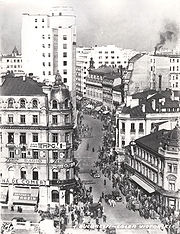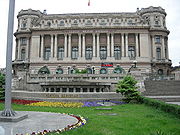
Calea Victoriei
Encyclopedia

Bucharest
Bucharest is the capital municipality, cultural, industrial, and financial centre of Romania. It is the largest city in Romania, located in the southeast of the country, at , and lies on the banks of the Dâmbovița River....
. It leads from Splaiul Independenţei (which runs parallel to the Dâmboviţa River
Dâmbovita River
Dâmbovița is a river in Romania. It has its sources in the Făgăraş Mountains, on the Curmătura Oticu. The upper reach of the rivers, upstream of the confluence with the Boarcăşu River is also known as Izvorul Oticului River or Oticu River....
) to the north and then northwest up to Piaţa Victoriei
Victory Square, Bucharest
Victory Square is a major intersection in central Bucharest, where Calea Victoriei, Lascăr Catargiu Boulevard, Iancu de Hunedoara Boulevard, Kiseleff Boulevard, Ion Mihalache Boulevard and Nicolae Titulescu Boulevard cross....
, where Şoseaua Kiseleff
Soseaua Kiseleff
Şoseaua Kiseleff is a major road in Bucharest that runs as a northward continuation of Calea Victoriei. The road was created in 1832 by Pavel Kiselyov, the commander of the Russian occupation troops in Wallachia and Moldavia...
continues north.
History
Initially, the road was named Drumul Braşovului (Braşov Road), being part of the trade route between Bucharest and the city of BraşovBrasov
Brașov is a city in Romania and the capital of Brașov County.According to the last Romanian census, from 2002, there were 284,596 people living within the city of Brașov, making it the 8th most populated city in Romania....
, in Transylvania
Transylvania
Transylvania is a historical region in the central part of Romania. Bounded on the east and south by the Carpathian mountain range, historical Transylvania extended in the west to the Apuseni Mountains; however, the term sometimes encompasses not only Transylvania proper, but also the historical...
.
Between 1692 and 1700, a paved road which linked the centre of Bucharest to the Mogoşoaia Palace
Mogosoaia Palace
Mogoşoaia Palace is situated about 10 kilometres from Bucharest, Romania. It was built between 1698-1702 by Constantin Brâncoveanu in what is called the Romanian Renaissance style or Brâncovenesc style, a combination of Venetian and Ottoman elements...
of Constantin Brâncoveanu
Constantin Brâncoveanu
Constantin Brâncoveanu was Prince of Wallachia between 1688 and 1714.-Ascension:A descendant of the Craioveşti boyar family and related to Matei Basarab, Brâncoveanu was born at the estate of Brâncoveni and raised in the house of his uncle, stolnic Constantin Cantacuzino...
was built and it was named Podul Mogoşoaiei, being made out of oak
Oak
An oak is a tree or shrub in the genus Quercus , of which about 600 species exist. "Oak" may also appear in the names of species in related genera, notably Lithocarpus...
wood.
Most roads in the Balkans
Balkans
The Balkans is a geopolitical and cultural region of southeastern Europe...
at that time became muddy in the spring and autumn, and the wood prevented this. Consequently the road was one of the most important construction works of the area and a source of pride to Bucharesters. The area surrounding the road became the most fashionable part of Bucharest: 35 boyar
Boyar
A boyar, or bolyar , was a member of the highest rank of the feudal Moscovian, Kievan Rus'ian, Bulgarian, Wallachian, and Moldavian aristocracies, second only to the ruling princes , from the 10th century through the 17th century....
houses were located on the road itself in 1775.
Podul Mogoşoaiei was the first street in Bucharest to be illuminated with candle
Candle
A candle is a solid block or cylinder of wax with an embedded wick, which is lit to provide light, and sometimes heat.Today, most candles are made from paraffin. Candles can also be made from beeswax, soy, other plant waxes, and tallow...
s during the night, starting July 1814.
The wood was not a very sturdy material and often it was in a bad state, despite being repaired several times (including in 1793 and 1814). During the Russia
Russia
Russia or , officially known as both Russia and the Russian Federation , is a country in northern Eurasia. It is a federal semi-presidential republic, comprising 83 federal subjects...
n occupation of the Danubian Principalities
Danubian Principalities
Danubian Principalities was a conventional name given to the Principalities of Moldavia and Wallachia, which emerged in the early 14th century. The term was coined in the Habsburg Monarchy after the Treaty of Küçük Kaynarca in order to designate an area on the lower Danube with a common...
, in the aftermath of the Russo-Turkish War (1828–1829), an extension
Soseaua Kiseleff
Şoseaua Kiseleff is a major road in Bucharest that runs as a northward continuation of Calea Victoriei. The road was created in 1832 by Pavel Kiselyov, the commander of the Russian occupation troops in Wallachia and Moldavia...
from Piaţa Victoriei northward was built by Pavel Kiseleff, the commander of the occupation troops, and is today named after him. In 1842 the road was paved with cobblestone
Cobblestone
Cobblestones are stones that were frequently used in the pavement of early streets. "Cobblestone" is derived from the very old English word "cob", which had a wide range of meanings, one of which was "rounded lump" with overtones of large size...
. It was later upgraded to asphalt
Asphalt
Asphalt or , also known as bitumen, is a sticky, black and highly viscous liquid or semi-solid that is present in most crude petroleums and in some natural deposits, it is a substance classed as a pitch...
.
The road was renamed "Calea Victoriei" on October 12, 1878, following the Romanian victory in the Independence War of 1877-1878
Romanian War of Independence
The Romanian War of Independence is the name used in Romanian historiography to refer to the 1877-1878 Russo-Turkish war, following which Romania, fighting on the Russian side, gained independence from the Ottoman Empire...
.



Buildings and monuments
Major buildings and monuments along the street include (from north to south):- The Cantacuzino Palace, hosting The George Enescu Museum
- Museum of Art CollectionsMuseum of Art CollectionsThe Museum of Art Collections is a branch of the National Museum of Art of Romania and is situated in Bucharest. It contains 44 collections donated to the Romanian State beginning with 1927 by the families of: Hurmuz Aznavorian, Dumitru and Maria Ştefănescu, Josefina and Eugen Taru, Emanoil Romulus...
- Ştirbey Palace
- The Athénée PalaceAthénée PalaceThe Athénée Palace hotel in Bucharest, Romania, now a Hilton, may have been Europe's most notorious den of spies in the years leading up to World War II, and only slightly less so during the Cold War. Located in the heart of Bucharest on Str...
Hotel, now a HiltonHilton HotelsHilton Hotels & Resorts is an international chain of full-service hotels and resorts founded by Conrad Hilton and now owned by Hilton Worldwide. Hilton hotels are either owned by, managed by, or franchised to independent operators by Hilton Worldwide. Hilton Hotels became the first coast-to-coast... - Romanian AthenaeumRomanian AthenaeumThe Romanian Athenaeum is a concert hall in the center of Bucharest, Romania and a landmark of the Romanian capital city. Opened in 1888, the ornate, domed, circular building is the city's main concert hall and home of the "George Enescu" Philharmonic and of the George Enescu annual international...
- National Museum of Art of RomaniaNational Museum of Art of RomaniaThe National Museum of Art of Romania is located in the former royal palace in Revolution Square, central Bucharest, Romania, completed in 1937...
- The libraryCentral University Library of BucharestThe Central University Library of Bucharest is a library in central Bucharest, located across the street from the National Museum of Art of Romania....
of the University of BucharestUniversity of BucharestThe University of Bucharest , in Romania, is a university founded in 1864 by decree of Prince Alexander John Cuza to convert the former Saint Sava Academy into the current University of Bucharest.-Presentation:... - Kretzulescu ChurchKretzulescu ChurchKretzulescu Church is an Eastern Orthodox church in central Bucharest, Romania. Built in the Brâncovenesc style, it is located on Calea Victoriei, nr. 45A, at one of the corners of Revolution Square, next to the former Royal Palace....
- Piaţa RevoluţieiRevolution Square, BucharestRevolution Square is a square in central Bucharest, on Calea Victoriei. Known as Piaţa Palatului until 1989, it was later renamed after the 1989 Romanian Revolution....
(Revolution Square), including the Memorial of RebirthMemorial of RebirthThe Memorial of Rebirth is a memorial in Bucharest, Romania that commemorates the struggles and victims of the Romanian Revolution of 1989, which overthrew Communism... - Palatul TelefoanelorPalatul TelefoanelorBucharest Telephone Palace is an office building located on Calea Victoriei in Bucharest, Romania. It serves as the headquarters of Romtelecom.-Bucharest:Palatul Telefoanelor in Bucharest is an art deco style building...
- Odeon Theatre
- Casa CapşaCasa CapsaCasa Capşa is a historic restaurant in Bucharest, Romania, first established in 1852. At various times it has also included a hotel; most recently, it reopened as a 61-room hotel 17 June 2003....
- Cercul Militar Naţional
- Pasajul Macca-VilacrossePasajul Macca-VilacrossePasajul Macca-Vilacrosse is a fork-shaped, yellow glass covered arcaded street in downtown Bucharest, Romania. Câmpineanu Inn once stood in the place nowadays occupied by the passage....
- Bucharest Financial PlazaBucharest Financial PlazaBucharest Financial Plaza is a class A office building in Bucharest. It has 18 floors and a surface of 30.000 sqm. It also has 3 underground floors which are used as parking spaces for 160 cars....
- National Museum of History of Romania
- Casa de Economii şi Consemnaţiuni (CEC)
It was also long home to the Constantin Tănase
Constantin Tanase
Constantin Tănase was a Romanian actor and writer for stage, a key figure in the revue style of theater in Romania.-Life:Born into a working-class family living in a peasant house in Vaslui, Romania...
Revue Theatre (as of 2006, relocated to the Lipscani
Lipscani
Lipscani is a street and a district of Bucharest, Romania, which in the Middle Ages was the most important commercial center of Bucharest and the whole Wallachia...
district), and was the site of the old Romanian National Theater just north of Palatul Telefoanelor; the departed theatre's façade is replicated by the front of the Bucharest Novotel
Novotel
Novotel is a mid-scale hotel brand within the Accor group. Novotel has close to 400 hotels and resorts in 60 countries, situated in the business districts and tourist destinations of major international cities.-History:...
that opened in summer 2006. The Romanian Athenaeum
Romanian Athenaeum
The Romanian Athenaeum is a concert hall in the center of Bucharest, Romania and a landmark of the Romanian capital city. Opened in 1888, the ornate, domed, circular building is the city's main concert hall and home of the "George Enescu" Philharmonic and of the George Enescu annual international...
is set back slightly from the street, with a small park in between.
Calea Victoriei was Bucharest's showpiece street in the Interwar years. Tudor Octavian wrote, "this is how the whole of Bucharest would look if we had been allowed…, if its builders had been clever enough…". After roughly half a century of decline, it has recently been returning to this role. The National Museum of Art of Romania (the former royal palace) and the University Library across the street from it (both damaged in the 1989 Revolution
Romanian Revolution of 1989
The Romanian Revolution of 1989 was a series of riots and clashes in December 1989. These were part of the Revolutions of 1989 that occurred in several Warsaw Pact countries...
) were restored in the 1990s; Palatul Telefoanelor was restored between 1997–2005; and there has been an ongoing refurbishment of the street's many hotels, including the Athénée Palace, the Majestic, the Capitol, and the Capşa Hotel; as of 2010, the Grand Hotel du Boulevard is undergoing restoration, while renovation of the Continental and Novotel has been completed.

